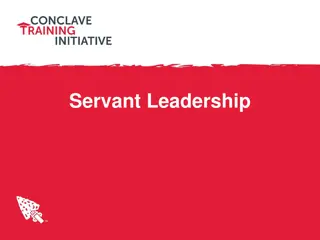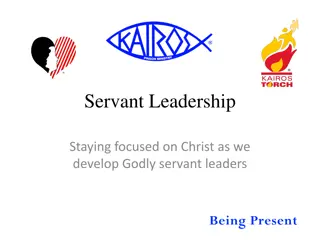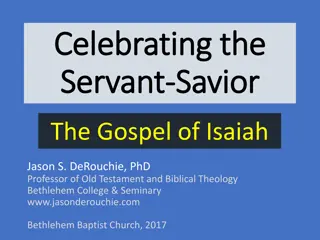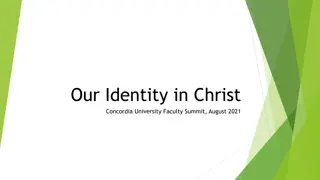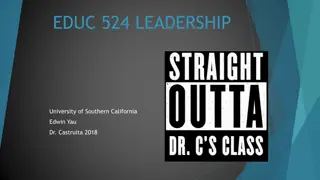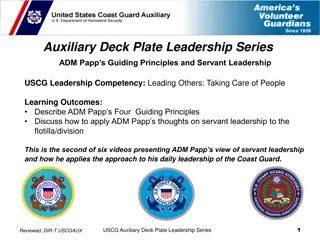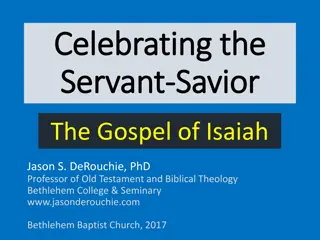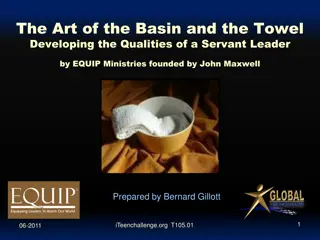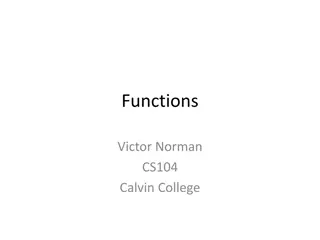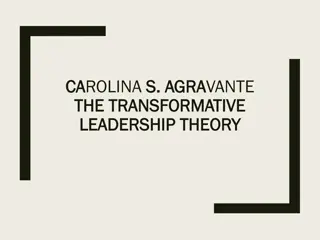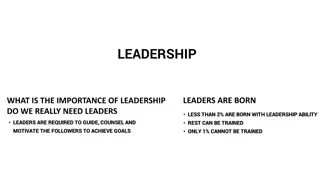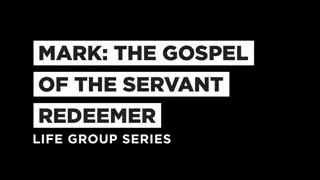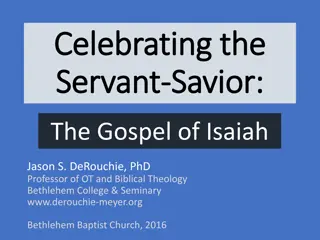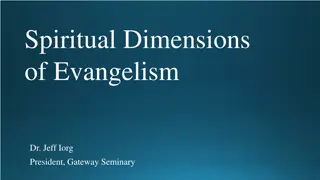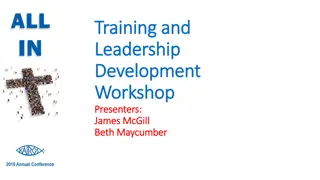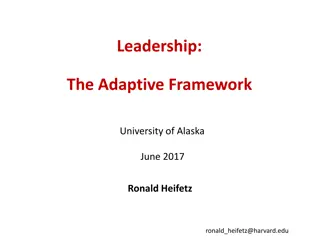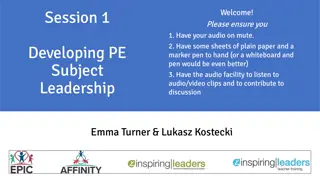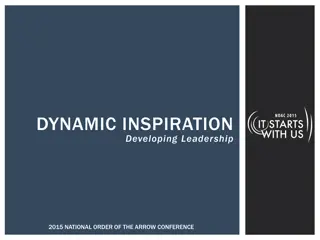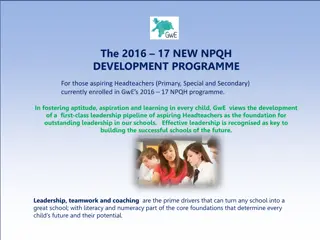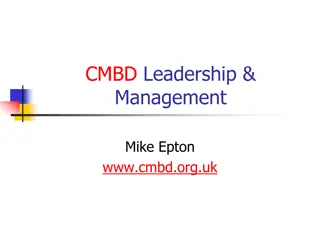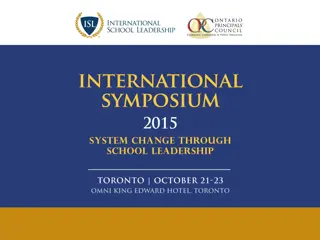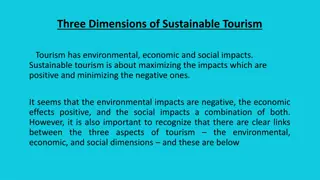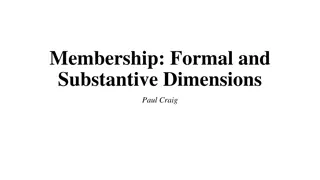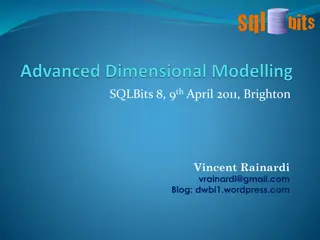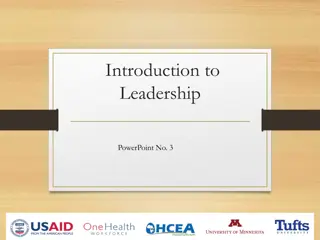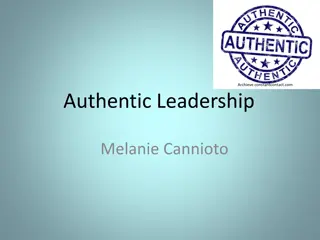Understanding Fruitful Servant Leadership Dimensions
The focus of fruitful servant leadership is on the growth and development of individuals within the congregation. It involves spiritual, emotional, and leadership maturity to help people recognize their purpose, instill hope, and achieve transformational goals in alignment with United Methodist polity and vision.
Download Presentation

Please find below an Image/Link to download the presentation.
The content on the website is provided AS IS for your information and personal use only. It may not be sold, licensed, or shared on other websites without obtaining consent from the author. Download presentation by click this link. If you encounter any issues during the download, it is possible that the publisher has removed the file from their server.
E N D
Presentation Transcript
STAFF PARISH RELATIONS COMMITTEE Hector Burgos Capital District Superintendent Sang-Won Doh Raritan Valley District Superintendent
Desired Outcomes Understanding of servant leadership Understanding of servant leadership in the Wesleyan tradition in the Wesleyan tradition Knowledge of your role and Knowledge of your role and responsibilities responsibilities Clarity & alignment with United Clarity & alignment with United Methodist polity, and GNJ vision, Methodist polity, and GNJ vision, values, goals, and strategic priorities values, goals, and strategic priorities
SERVANT LEADERSHIP The focus of servant leadership is primarily on The focus of servant leadership is primarily on the growth and development of the people the growth and development of the people and the congregation to which they belong. and the congregation to which they belong. Servant Leaders share power, put the needs of others first, and help people develop and produce abundant good fruits in their discipleship and ministry.
DIMENSIONS OF FRUITFUL SERVANT LEADERS SPIRITUAL MATURITY SPIRITUAL MATURITY People recognize they have meaning, experience God s calling, and live their purpose in life.
DIMENSIONS OF FRUITFUL SERVANT LEADERS EMOTIONAL MATURITY EMOTIONAL MATURITY People have People have hope hope because they matter just like the they matter just like the leader and they are part of leader and they are part of an important mission an important mission because
DIMENSIONS OF FRUITFUL SERVANT LEADERS LEADERSHIP MATURITY LEADERSHIP MATURITY The congregation, ministry The congregation, ministry or organization achieves or organization achieves goals and transformational goals and transformational results that move the results that move the mission forward. mission forward.
DIMENSIONS OF FRUITFUL SERVANT LEADERS SPIRITUAL MATURITY SPIRITUAL MATURITY EMOTIONAL MATURITY EMOTIONAL MATURITY LEADERSHIP MATURITY LEADERSHIP MATURITY What dimension(s) and one or two attribute(s) of servant leadership do you need to pay special attention and develop over the next year to grow in your discipleship and leadership? Note: Three dimensions could be Note: Three dimensions could be inserted into a pyramid shape or inserted into a pyramid shape or cycles that show interconnections cycles that show interconnections
SPRC Membership Composed of 5 to 9 professing members of the congregation. Three years term. One member shall be a young adult and one member a youth (when possible). The congregation s lay leader and lay delegate to AC are members at large. No staff or immediate family member of a pastor or staff can serve in this committee. Only one person from an immediate family residing in the same household can serve in this committee.
SPRC Meetings Basics The committee shall meet at least quarterly. It shall meet additionally at the request of the bishop, the district superintendent, the pastor, or any other person accountable to the committee, or the chairperson of the committee. The committee shall meet only with the knowledge of the pastor and/or the district superintendent. The pastor shall be present at each meeting of the committee, except where he or she voluntarily excuses himself/herself.
SPRC Meetings Basics The committee may meet with the district superintendent without the pastor or appointed staff under consideration being present. However, the pastor or appointed staff under consideration shall be notified prior to such meeting with the district superintendent and be brought into consultation immediately thereafter. The committee shall meet in closed session, and information shared in the committee shall be confidential confidential.
Meet Meet at least once every quarter. at least once every quarter. Set regular meeting dates in advance. Beginning/ending on meeting dates in advance. Beginning/ending on time. time. Set regular Opening devotion and prayer (rotate) Opening devotion and prayer (rotate) Effective SPRC Meetings Minutes reviewed & approved (confidential) Minutes reviewed & approved (confidential) Check Check- -in regarding lay staff (through in regarding lay staff (through supervisor/senior pastor). supervisor/senior pastor). Check Check- -in with Pastor(s) in with Pastor(s) What are the joys of ministry that the pastor(s) is experiencing? What are the joys of ministry that the pastor(s) is experiencing? What are the challenges and struggles that the pastor(s) is experiencing? What What are the challenges and struggles that the pastor(s) is experiencing? What has been done to address these, and how can the SPRC be supportive and has been done to address these, and how can the SPRC be supportive and helpful? helpful? How has the pastor(s) been utilizing his/her time? How does this align with the How has the pastor(s) been utilizing his/her time? How does this align with the church s mission and vision? If there is concerns, what needs to be different church s mission and vision? If there is concerns, what needs to be different moving forward? moving forward?
Personnel policies, staffing needs Personnel policies, staffing needs Review decision and assignments Review decision and assignments Closing Prayer & Sending Forth Closing Prayer & Sending Forth Effective SPRC Meetings **Staff Parish Relations Committees are confidential, closed meetings. All members of the committee should be reminded of this at each meeting. If a person does not feel that they can maintain confidence, they should speak to the chair or the pastor and ask to serve in some other capacity.
1. Encourage, strengthen, nurture, support, and respect the pastor(s) and staff and their family(ies). 2. Promote unity in the church(es). 3. Maximize pastor/staff gifts; relationships with the congregation; pastor/ staff health & self-care. 4. Provide ongoing feedback and complete a yearly evaluation - pastor & congregation. Essential SPRC Responsibilities 5. Create Job descriptions for the lay staff & appointed associates. 6. Align the congregation with GNJ and the greater United Methodist Connection.
7. 7. Create, Review, Revise staff policy manual Create, Review, Revise staff policy manual (including Safe Sanctuary policy & sexual (including Safe Sanctuary policy & sexual misconduct policy). misconduct policy). 8. 8. Recommend staffing needs to the church council. Recommend staffing needs to the church council. 9. 9. Hire, Evaluate and Discontinue Staff (working Hire, Evaluate and Discontinue Staff (working through the Senior Pastor) through the Senior Pastor) 10. 10. Endorse and support new candidates for ministry Endorse and support new candidates for ministry (including promoting ministry & Methodist (including promoting ministry & Methodist Education Fund) Education Fund) Essential SPRC Responsibilities
1. 1. The Transition The Transition- -Out Meeting and Preparing for new Out Meeting and Preparing for new appointment (Consultation) appointment (Consultation) 2. 2. The Transition The Transition- -In Meeting (Affirmation or request for In Meeting (Affirmation or request for reconsideration) reconsideration) 3. 3. Announcement in both appointments on Sunday Announcement in both appointments on Sunday morning morning The Appointment Process 4. 4. The Transition Process The Transition Process Creating a Transition Team Creating a Transition Team Transition Worship Transition Worship Cross Cross- -Cultural/Racial Training Cultural/Racial Training 18 18- -Months Review Process Months Review Process
LEADING LEADING THROUGH THROUGH CONFLICT CONFLICT Central Region Central Region NICOLA MULLIGAN NICOLA MULLIGAN
Every congregation experiences conflict as a part of normal, healthy growth and change. These periods of conflict can be difficult for individuals and congregations.
Healthy relationships include: Communicating honestly Reconciling willingly Sharing and receiving forgiveness
If another member of the church sins against you, go and point out the fault when the two of you are alone. If the member listens to you, you have regained that one. 1. COMMUNICATE Matthew 18:15
But if you are not listened to, take one or two others along with you, so that every word may be confirmed by the evidence of two or three witnesses. 2. COMPANIONS Matthew 18:16
If the member refuses to listen to them, tell it to the church. 3. COUNCIL Matthew 18:17
LEADING THROUGH CONFLICT
How to Assess the 5 levels of Conflict Level One: Problem Solving Conversation and compromise by leaders is used to address conflicting needs from various parts or individuals in the congregation.
Level Two: Disagreement Differing expectations and needs require negotiation, possible use of a congregational team trained in conflict resolution or conference staff.
Level Three: Contest Level Win/lose, factions emerging, personal attacks, people threatening to leave or withhold giving.
Level Four: Fight/Flight People leaving, loyalty to sub-group is more important than commitment to the church as a whole
Level Five: Intractable No one is talking to anyone else, positions are fixed and no one is willing to budge
LEADING THROUGH CONFLICT Clarity Issues
Congregations and organizations will function so that differing ideas and expectations are not suppressed but explored.
People will not engage from personal agendas but missional outcomes. How will this idea or expectation further the mission of the church to make disciples and grow vital congregations to transform the world.
Clergy and congregational leadership will not ignore conflict including early signs of conflict but engage and lead conflict resolution using the Matthew 18 paradigm.
Congregations will manage conflict at levels 1 and 2, and seek GNJ leadership support at levels 3, 4 and 5.
Congregations will engage conflict through prayer, respect for others and focusing on issues rather than personalities and personal agendas
We honor God when we work to resolve differences, offer forgiveness and reconcile differences within the congregation
THANK YOU Nicola Mulligan, Executive Assistant to Bishop nmulligan@gnjumc.org
QUESTIONS & CONVERSATION


